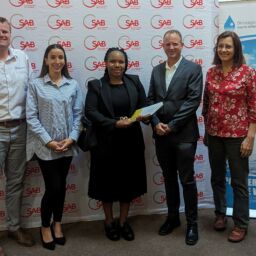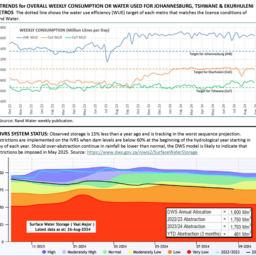
As Gauteng, South Africa’s economic heartland, teeters on the brink of a devastating water crisis, the Strategic Water Partners Network (SWPN) stepped up to the plate, mobilising a coordinated, multi-stakeholder response to avert disaster.
The Looming Catastrophe
Neglected infrastructure, ballooning demand, and rampant non-revenue water losses has pushed the province’s water supply to the brink. As Dr. Sean Phillips, Director-General of the Department of Water and Sanitation, warned, “We’re now in a situation where the demand for treated water in Gauteng is already occasionally exceeding the supply, particularly during peaks of demand.” With reservoirs draining during power outages and municipalities struggling to refill depleted reserves, the crisis threatens to grind industries to a halt and leave over 13 million residents high and dry. Nandha Govender, General Manager at Eskom, underscores the severity, noting, “We are part of a system. We cannot act as if we are not impacted.”
Catalysing a Collaborative Response
Recognising the urgent need for action, the SWPN, a partnership between government, civil society, and the private sector, leveraged its unique position to convene key stakeholders and drive a comprehensive, multi-pronged response. Representing the SWPN and NEPAD Business Foundation, Peter Varndell said, “We realised that a collective effort was the only way to tackle this crisis head-on. By bringing together the Department of Water and Sanitation, Rand Water, Eskom, and private sector leaders, we could align on the root causes, coordinate interventions, and mobilise resources at the scale required.”
Tackling Non-Revenue Water
One of the SWPN’s key priorities is addressing the staggering water losses plaguing Gauteng’s municipalities. As Salome Chiloane-Nwabueze of Rand Water lamented, “We are losing more than 40% of our water that we are distributing to our customers.” Working closely with municipalities like Polokwane, the SWPN supported the development and implementation of non-revenue water reduction strategies, leveraging expertise and funding from its private sector partners. “These projects not only stemmed the flow of lost water, but also helped municipalities to shore up their revenue collection and financial sustainability,” Varndell explained.
Unlocking Private Sector Contributions
The SWPN also leveraged its private-sector partnerships to unlock much-needed investment and innovation. “Companies were eager to contribute, whether through direct funding for municipal projects, piloting new water-saving technologies, or advocating for water stewardship among their employees and supply chains,” Varndell noted. One such example was the SWPN’s collaboration with SAB and Anglo-American to establish non-revenue water reduction funds, providing municipalities with the resources and expertise to tackle this critical issue.
A Collective Way Forward
While the Gauteng water crisis is far from over, the SWPN’s efforts will help turn the tide, bridging the gap between government, industry, and communities to implement sustainable solutions. “The key has been our ability to convene diverse stakeholders, align on priorities, and catalyse action,” said Varndell. “By fostering transparency, building trust, and harnessing the collective power of our partners, we’re confident that Gauteng can weather this storm and emerge more resilient than ever.” As the province continues its race against time, the SWPN remains steadfast in its commitment to supporting the Department of Water and Sanitation, Rand Water, and municipalities in their efforts to secure a sustainable water future for all.










